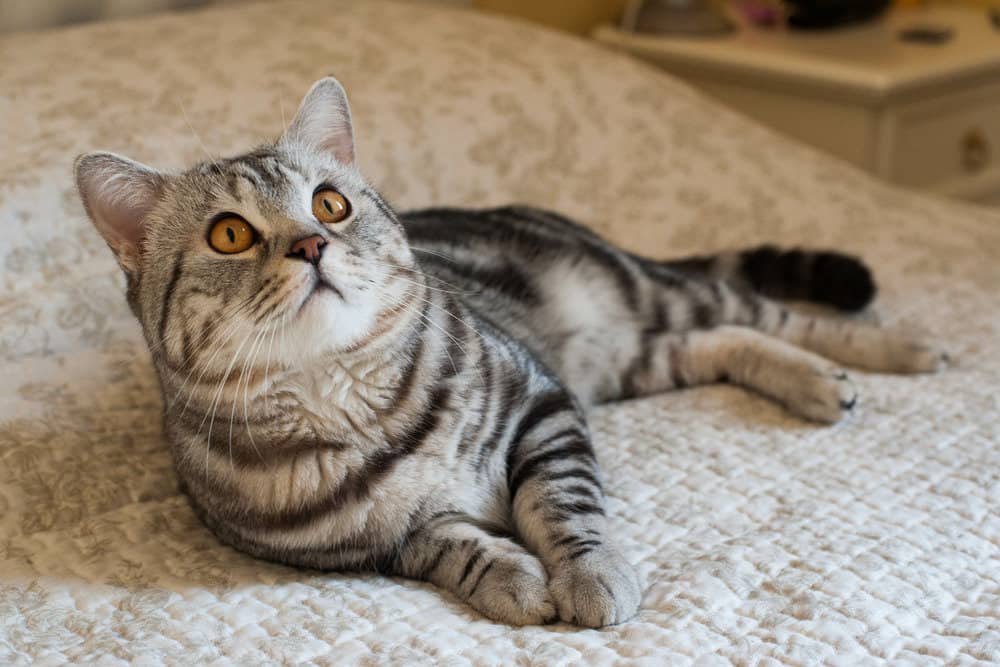If you’re in the market for a feline friend, the American Shorthair cat breed might just be your ideal companion. These cats have a long history, a charming temperament, and an enduring popularity that makes them a top choice for pet owners. In this article, we’ll take you on a journey through the fascinating world of American Shorthair cats. You’ll discover their origins, their wonderful temperament, and the essential care they need to thrive as your furry family member.
American Shorthair Cat & Kitten Photos/Images
American Shorthair Cat Weight Range:
Male: large: >12 lbs.
Female: medium: 8-12 lbs.
American Shorthair Cat Eye Colour:
Blue, Copper, Green, Gold, Hazel, Odd-eyed
American Shorthair Cat Lifespan & Expectations:
Lifespan Longevity Range: 15-20 years
Social/Attention Needs: High
Tendency to Shed: Moderate
American Shorthair Cat Coat Details:
Length: Short
Characteristics: Straight
Colors: White, Blue, Black, Cream, Red, Silver, Golden, Brown, Cameo, Bluecream, Tortoiseshell, Chinchilla
Pattern: Solid color, Tortoiseshell, Bicolor, Tricolor/Calico, Tabby, Smoke, Shaded
Less Allergenic: No
Overall Grooming Needs: Moderate
American Shorthair Cat/Kitten Price In India
The cost of an American Shorthair cat in India can vary depending on several factors such as location, breeder reputation, age, gender, and color. Generally, American Shorthair cat price in India can cost anywhere between Rs. 40,000 to Rs. 80,000.
History and Origin
Ancient Origins
The story of the American Shorthair begins centuries ago, in a world far removed from today’s modern domestic life. These cats are descendants of European cats that traveled across the ocean with early American settlers, primarily in the 1600s and 1700s. These cats weren’t pampered pets; instead, they served as essential companions, helping to control the rodent population on ships and farms.
American Evolution
Over time, these European cats adapted to the American environment and lifestyle. They interbred with other cats that arrived with different waves of immigrants, creating a diverse and robust feline population. This mingling of genes gave rise to the American Shorthair breed we know today.
Historical Significance
American Shorthairs played a vital role in the history of the United States. They were cherished for their hunting skills, which helped protect food stores from pests. These cats were so esteemed that they even earned a place in the annals of American literature and art, appearing in stories like Mark Twain’s “The Celebrated Jumping Frog of Calaveras County.”
Personality and Temperament of American Shorthair Cats
Friendly and Adaptable
American Shorthair cats are known for their amiable and adaptable nature. They are sociable without being overly demanding, making them great companions for families and individuals alike. Their friendly disposition extends to other pets, so if you have a dog or another cat, an American Shorthair is likely to get along just fine.
Playful and Inquisitive
These cats are not only friendly but also quite playful and inquisitive. They love interactive play and exploring their surroundings. So, don’t be surprised if your American Shorthair frequently pounces on toys or investigates every nook and cranny of your home.
Independent but Affectionate
While they enjoy play and interaction, American Shorthairs also value their independence. They are content to curl up by your side or on a sunny windowsill, and they’re not prone to excessive clinginess. Yet, they’re affectionate in their own way, often seeking out gentle pets and chin scratches.
Health and Common Health Issues of American Shorthair Cats
Robust Health
American Shorthair cats are generally healthy and hardy. However, like all breeds, they can be prone to certain health issues. These may include dental problems, heart disease, and obesity. Regular vet check-ups are crucial to ensure your cat’s well-being.
Preventive Care
Preventive care is key to keeping your American Shorthair in top shape. Ensure they receive their vaccinations on schedule and maintain a proper diet to prevent obesity. Regular dental check-ups are also essential for their oral health.
Grooming Needs
As the name suggests, American Shorthairs have short, low-maintenance coats. Brushing them occasionally helps reduce shedding and keeps their fur looking its best. Besides that, they are relatively fuss-free when it comes to grooming.
Conclusion
In conclusion, the American Shorthair cat breed offers a delightful blend of history, temperament, and health. Their centuries-old lineage and adaptability make them a unique part of American culture. Their friendly and playful disposition endears them to pet owners, while their low-maintenance grooming needs make them a practical choice. So, if you’re considering adding a feline friend to your family, the American Shorthair might be the perfect choice. With their rich history and wonderful personality, they’re sure to bring joy and companionship to your life. Why not consider adopting one today and become part of this breed’s enduring legacy?
While you’re here, you can also check out our article on Sphynx Cat breed.
Frequently Asked Questions About American Shorthair Cat
-
Is an American Shorthair a friendly cat?
Absolutely! American Shorthairs are known for their friendly and adaptable nature. They make wonderful companions for families and individuals due to their sociable yet independent disposition.
-
Are American Shorthair cats rare?
No, American Shorthair cats are not rare. In fact, they are one of the most popular and widely recognized cat breeds in the United States and beyond.
-
What is the price of American Shorthair in India?
The price of an American Shorthair cat in India can vary widely depending on factors like the breeder’s reputation, the cat’s lineage, and its age. On average, you can expect to pay between ₹40,000 to ₹80,000 or more for a purebred American Shorthair kitten.
-
Are American Shorthair cats expensive?
While American Shorthair cats are not among the most expensive cat breeds, they are not considered cheap either. Their price typically reflects their quality, pedigree, and the breeder’s reputation. Expect to invest a moderate amount to bring an American Shorthair into your home.
